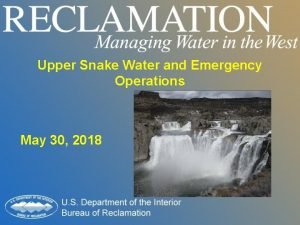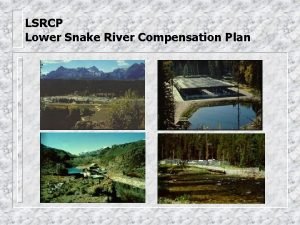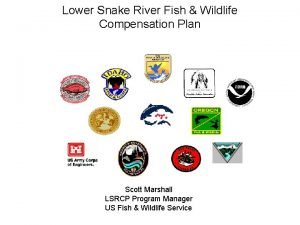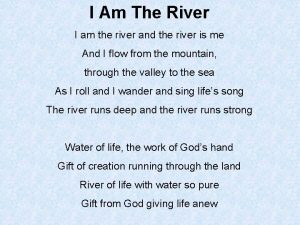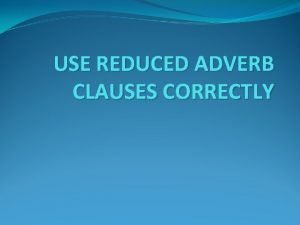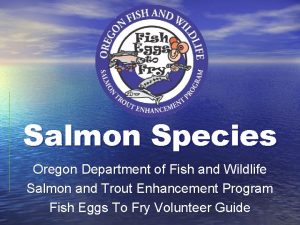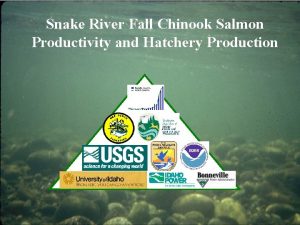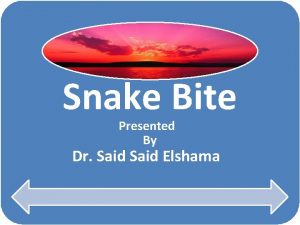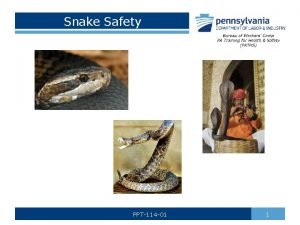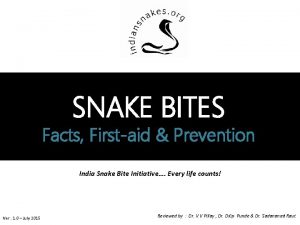NEW PIC New Perspectives Snake River Salmon and















- Slides: 15

NEW PIC New Perspectives Snake River Salmon and Steelhead By Linwood Laughy June, 2019

50+ Years of Contention Pacific Northwesterners have contentiously debated the issue of the four lower Snake River dams since before their construction in the 1960 s and 70 s.

The looming extinction of Southern Resident Killer Whales and collapsing Snake River salmon and steelhead runs have recently brought this simmering issue to a boil.

Three major elements define the debate: • Freight transportation • Hydropower • Snake River threatened and endangered salmon and steelhead. This presentation focuses on Snake River salmon and steelhead.

The problem of passing migratory fish over dams on lower Snake River was discussed with representatives of the U. S. Fish and Wildlife Service, State of Washington Department of Fisheries, Fish Commission of Oregon, Oregon State Game Commission, and the State of Idaho Department of Fish and Game. The consensus of opinion of these agencies was that any series of dams on lower Snake River would be hazardous and might entirely eliminate the runs of migratory fish in that stream. In view of the experience at Bonneville Dam, this office does not concur with this unfounded opinion. Special Report on Selection of Sites, Lower Snake River Oregon, Washington and Idaho -Corps of Engineers March 14, 1947

(Years in graph 1962 -2018) Historically, an estimated 1. 5 million wild spring/summer Chinook returned to the Snake River and its tributaries. • Snake River Spring/Summer Chinook and SR steelhead numbers plummeted in 1962 -1975, the same years the LSR dams were constructed. • After 30+ years and hundreds of millions of dollars, neither species is on a path to recovery.

-LOWER GRANITE -LITTLE GOOSE -LOWER MONUMENTAL -JOHN DAY -ICE HARBOR (Years in graph 1962 -2018) Historically, an estimated 150, 000 sockeye salmon returned each year to the Snake River basin. • Snake River sockeye numbers plunged between 1963 and 1990 during and following construction of the LSR dams. • The recovery goal for Snake River endangered wild sockeye salmon is 2, 500 fish at Lower Granite Dam. • The four-year total reaching the Stanley basin in 20152018 is 69 fish, an average of 17 per year.

• Pike minnows, bass and walleye thrive in warm water reservoirs, where they eat millions of salmon and steelhead smolts. • Delayed travel time through reservoirs upsets the juvenile salmons’ biological clock for transitioning from fresh to salt water. • Cormorants, terns and gulls dine on salmon smolts throughout their migratory journey. • Passage over, through or around 8 dams (tailrace to tailrace) takes a heavy cumulative toll. During an average water year, for every 1, 000 Snake River juvenile spring/summer Chinook that begin their migratory journey to the sea, approximately 858, 000 (86%) perish en route. • Delayed mortality — the physical damage and stress that result from passing 8 dams and reservoirs— wipes out at least 40% of remaining smolts below Bonneville Dam.

• From 1997 through 2017, average SARs for wild Chinook (Lower Granite dam to Lower Granite dam) averaged 0. 84%. SAR levels exceeded 2% in only 2 of 22 years. • SARs for wild spring/summer Chinook have declined four-fold since the lower Snake River dams were built. A Smolt-to-Adult Return rate (SAR) less than 1% indicates a species is on a path to extinction. Recovery of a species requires a SAR between 2% - 6%, with a 4% average. • SARs for Wild steelhead, with an average SAR of 1. 6%, declined nearly fourfold since dam construction and exceeded the 2% level only 4 times since 1994.

Climate change poses a new challenge for salmon and steelhead, which need water temperatures at or below 68 degrees. • Temperatures of 69 -70°F increase stress on adult fish and make them susceptible to disease. • At 70 -72°F, migration can slow or stop. • Temperatures of 72 -74°F can be lethal. • In 2015, temperatures in the Snake and Columbia Rivers exceeded 72°F for a total of 18 days, and more than 250, 000 adult salmon died.

• Six Columbia-Snake River dams have the greatest impact on increasing water temperatures. Four of the six are dams on the lower Snake River. • At each of the four LSR dams water temperatures can rise more than 1° Celsius. 20° C = 68°F 22° C = 71. 6°F 23° C = 73. 4°F The Environmental Protection Agency has estimated water temperatures in the Columbia and Snake Rivers with and without dams. • An increase of one degree Celsius raises water temperature from 68°F to 69. 8°F; an additional 1° Celsius results in an increase to 71. 6°F. • Temperature increases are normally cumulative.

• Between 2008 -2017, Columbia Basin F & W costs for Bonneville Power Administration averaged $727 million per year, about 24% of BPA’s nearly $3 Billion budget. • After 25+ years, no Columbia or Snake River threatened or endangered salmon or steelhead species is on a path to recovery. Over the past 20 years, taxpayers and electricity rate payers have incurred costs of $16. 8 Billion implementing a fish and wildlife program declared inadequate and illegal by three U. S. District judges. • Government agencies and special interest groups continue to support the status quo on the lower Snake River.

• A four-fold increase in Snake River spring/summer Chinook SARs would remove these fish from a path to extinction and approach the 4% average SAR needed for recovery. In 2017 the Fish Passage Center reported removal of the four dams on the lower Snake River and increased spill to the 125% gas cap at four dams in the lower Columbia could lead to a four-fold increase in Snake River salmon and steelhead SARs. • A four-fold increase in Snake River steelhead SARs would result in a solid recovery and potential delisting of this species from the Threatened and Endangered Species List.

• A free-flowing river would reduce juvenile salmon and steelhead migration travel times, reduce the number of piscine and avian predators en route, reduce water temperatures, and eliminate delayed mortality due to dam passage. • A free-flowing lower Snake River would provide over 200 miles of riparian habitat and the return of some or most of the 120, 000 game birds and 90 thousand song birds lost when the dams were constructed. • An estimated 18, 000 acres of land would become available for agricultural and other uses. Returning the lower Snake River to a more normal flow will yield positive economic, cultural and environmental outcomes. • Taxpayers would save many millions of dollars each year with sustainable Snake River fish runs, which would boost local economies from Astoria, Oregon to Stanley, Idaho.

Sources Slide 1: Betsey Thoennes (salmon) U. S. Army Corps of Engineers (fish ladder) Slide 2: Map from Spokesman Review http: //www. spokesman. com/blogs/outdoors/2017/mar/02/lower-snake-river-dams-conflict-depicted-1971 -wsudocumentary/ Slide 3: Betsey Thoennes (salmon and orca) Slide 4: Port of Lewiston (barge), Betsey Thoennes (salmon), U. S. Army Corps of Engineers (dam) Slide 5: Special Report on Selection of Sites, Lower Snake River Oregon, Washington and Idaho Corps of Engineers March 14, 1947 Slide 6: Idaho Department of Fish and Game Slide 7: Idaho Department of Fish and Game Slide 8 “Preliminary survival estimates for the passage of spring-migrating juvenile salmonids through Snake and Columbia River dams and reservoirs http: //pweb. crohms. org/tmt/agendas/2018/1003_2018_Preliminary_Survival_Estimates_Memo. pdf. Slide 9 Columbia Basin Research, DART (Data Access in Real Time) Slide 10 Fish Passage Center Comparative Survival Study of PIT-tagged Spring/Summer/Fall Chinook, Summer Steelhead, and Sockeye. Appendix A, Table A. 11 http: //fpc. org/documents/CSS/DRAFT 2017 CSS. pdf Slide 11 Environmental Protection Agency Agenhttps: //www. epa. gov/sites/production/files/2018 -05/documents/columbia-snake-tmdl-rbm 10 presentation-april-2018. pdf Slide 12 2018 Columbia Basin Fish and Wildlife Costs, Northwest Power Council https: //www. nwcouncil. org/sites/default/files/2019 -5_0. pdf page Slide 13 U. S. Army Corps of Engineers data reported by Columbia Basin Research at http: //www. cbr. washington. edu/hydro/lowergranite Slide 14 https: //www. nww. usace. army. mil/Library/2002 -LSR-Study/ Graphic Design: Amy Eberling
 Upper snake teacup
Upper snake teacup Lower snake river compensation plan
Lower snake river compensation plan Snake river robotics
Snake river robotics Lower snake river compensation plan
Lower snake river compensation plan Gregor andrade
Gregor andrade I am the river and the river is me
I am the river and the river is me New perspective marketing
New perspective marketing Tukwila
Tukwila The sun was salmon and hazy in the west figure of speech
The sun was salmon and hazy in the west figure of speech Reduced adverb clause
Reduced adverb clause Michaela salmon
Michaela salmon Grouper vs halibut
Grouper vs halibut Salmon smolt identification
Salmon smolt identification Chaines legeres libres
Chaines legeres libres Dr. j. douglas salmon jr
Dr. j. douglas salmon jr Salmon et durie
Salmon et durie
